- Home
- Rudy Rucker
Nested Scrolls
Nested Scrolls Read online
Contents
Death’s Door
Glowing Fog
The Suburbs
Schoolboy
On My Own
Curved Space
Following the Beats
Spring Blossoms
Summer of Love
White Light
Life with Kids
Ignition
Transrealism
Lynchburg?
Freelance Writer
Cyberpunk
Moving to California
Cellular Automata
Computer Hacker
Remember to Write
Reset
A Way Out?
I Retire
Old Master
Bibliography
Books
Books Edited
Software Packages
Death’s Door
In the summer of 2008 a vein burst in my brain. A cerebral hemorrhage. I spent a week at death’s door, and then I got better. In normal times I don’t think directly about death—it’s like trying to stare at the sun. But that summer I did think about it.
It would have been easy to die. Conditioned by a zillion novels and movies, you tend to think of death as a big drama—with a caped Grim Reaper kicking in your midnight door. But death may be as ordinary as an autumn leaf dropping from a tree. No spiral tunnel, no white light, no welcome from the departed ones. Maybe it’s just that everything goes black.
In those first mornings at the hospital, I’d sit on their patio with an intravenous drip on a little rolling stand, and I’d look at the clouds in the sky. They drifted along, changing shapes, with the golden sunlight on them. The leaves of a potted palm tree rocked chaotically in the gentle airs, the fronds clearly outlined against the marbled blue and white heavens. Somehow I was surprised that the world was still doing gnarly stuff without any active input from me.
I think this was when I finally came to accept that the world would indeed continue after I die. Self-centered as I am, this simple fact had always struck me as paradoxical. But now I understood it, right down in my deepest core. The secrets of the life and death are commonplace, yet only rarely can we hear them.
Sitting on that patio—and even more so when I came home—I came to understand another natural fact as well. The richest and most interesting parts of my life are the sensations that come in from the outside. As long as I’d been in my hospital bed, the world was dull and gray. I’d been cut off from external input, halfway down the ramp into the underworld. When I made it back to the trees, people, clouds, and water, I was filled with joy at being alive. It was like being born.
I had a similar rebirth experience right before my fourteenth birthday in 1960. My big brother Embry and I were in the back yard playing with our rusty old kiddie swing set—seeing who could jump the furthest. The chain of the swing broke. I flew through the air and landed badly, rupturing my spleen—as I immediately told my father. I might have died of internal bleeding in less than an hour if he hadn’t rushed me to the hospital to have the crushed spleen removed.
What made me think it was my spleen? I’d been studying a paperback book about karate in the hope of making myself less vulnerable to the hoodlum bullies I feared, also I’d been (fruitlessly) trying to build up karate-calluses on my hands by pounding them into a coffee-can of uncooked rice. My karate book had a chart of attack points on the body, and there was one in the belly area marked “spleen”—so I happened to make the right guess. Our doctor talked about this for years.
After the operation, I woke in the night from dreams of struggle to see an attractive private nurse leaning over me. I realized with embarrassment that this pleasant woman, one of my father’s parishioners, was the unseen force whom I’d been fighting and soddenly cursing while trying to pull a painfully thick tube from my nose.
When I came home from the gray and white hospital room, it was springtime, and our back yard was sunny and green. The shiny magnolia tree was blooming, the birds were fluttering and chirping, the blue sky shone above our familiar house. I was flooded with sweetness, dizzy with joy, trembling and on the verge of tears. I’d never realized how wonderful my life was.
In the coming weeks and months, I’d occasionally brood over that blank interval when I was under the anesthetic. I drew the conclusion that someday I’d go unconscious for good, like, bam and then—nothing. This was my introduction to life’s fundamental puzzler koan: Here you are, and life is great, but someday you’ll be dead. What can you do about it?
I used to imagine that I’d live to be eighty-four, but after my brain hemorrhage on July 1, 2008, I started thinking I might not last so long. Suppose that I only had time to write one more book. What should I write? This book. My memoir. Nested Scrolls.
Actually, I’d already started thinking about writing a final memoir back in 2003. I’d been out backpacking that time, and I was on a rocky beach in Big Sur, with the sun going down. I was thinking about my recently deceased friend Terence McKenna—with whom I’d once led an utterly bogus but enjoyable seminar at the new age Esalen hot springs resort nearby, a three-day class called, I think, “Stoneware and Wetware.”
A seagull looked at me. His eyes disappeared when seen directly head-on. Using my ever-present roller-ball pen and pocket-scrap of paper, I drew him in four or five positions. He was staring out to sea, cawing, looking at me, glancing at the shore, looking down at his feet. I don’t draw especially well, but sometimes I do it as a way of focusing my perceptions, or as a way to grab a kind of souvenir. Like a snapshot.
Sulfur smell wafted from a stream raging into the restless sea. I felt lucky to be on this wild shore.
“I love you,” I said to the seagull. He bowed. We repeated this exchange. Maybe the seagull was Terence.
I’d set out on my backpacking trip with a hope of deciding what to write next. And, looking at the seagull, the notion of an autobiography popped into my head. I was seeing it in terms of settling scores and taking credit. And I liked that I wouldn’t have to learn anything new to write it.
But I wasn’t ready. First I wanted to analyze the deeper meaning of computers, by writing a hefty volume with a long title: The Lifebox, the Seashell and the Soul: What Gnarly Computation Taught Me About Ultimate Reality, the Meaning of Life, and How To Be Happy. This non-fiction tome appeared in 2005, and then I got into dramatizing its new ideas in the context of three science fiction novels: Mathematicians in Love, Postsingular and Hylozoic. And then, unexpectedly, in 2008 I had to swing by death’s door.
I’m no longer very interested in the self-promotional aspects of an autobiographical memoir. As dusk falls, however rapidly or slowly, what I’m looking for is understanding and—time travel. A path into my past.
The thing I like about a novel is that it’s not a list of dates and events. Not like an encyclopedia entry. It’s all about characterization and description and conversation. Action and vignettes. I’d like to write a memoir like that.
Most lives don’t have a plot that’s as clear as a novel’s. But maybe I can discover, or invent, a story arc for my life. I’d like to know what it was all about.
Four years before starting this memoir—that is, back in 2004—I retired from my job as a professor of computer science at San Jose State University in Silicon Valley. I taught for thirty-seven years, sometimes taking a semester or two off. Although I always felt good about the social usefulness of teaching, I also regarded it as a day-job, with my writing being my real job. Once I was old enough to get a pension, I was happy to step away from teaching and put my full energy into writing.
Being retired felt weird at first. When you quit a job, you’re losing part of your identity.
During my second winter off, in 2005, I spent a few days organiz
ing my papers in the basement. I had a lot of stuff—reaching all the way back to a carton of papers my mother had stored—I had drawings from kindergarten, letters to friends and family, love notes to my girlfriend (and eventual wife) Sylvia, early literary efforts, volume upon volume of journals, traces of my teaching and research, novel notes—and unclassifiable late-night scribbles from me, as dogfather, creeping up from the family den to howl at the moon.
I looked at everything and organized it into four plastic boxes with hanging file holders. I physically touched all of them, and for a little while I knew where they all were.
There’s something deeply melancholy about old papers. I’m kind of hoping I don’t have to root around in them again. I’d rather wing my autobiography, as if I were talking to you during a car-trip, letting the important stories bubble up.
The one basement paper that I’ll mention was a little journal that my mother’s mother kept when she was born. On the first page I saw my mother’s name and birth-year—Marianne von Bitter, 1916—and pressed into the journal were two of my dear mother’s y’d been snipped the day be curls. Blonder than I would have expected, and very fresh-looking, as if the fore, rather than ninety years ago. I kissed them.
I was pretty bewildered, that first month after my cerebral hemorrhage. I felt like my mind was a giant warehouse where an earthquake had knocked everything off the racks—and I had to reshelve things one by one. I was, like, “Oh, yes, that’s a steam shovel, that’s a potty, that’s a quartz crystal, that’s my first day of nursery school.”
Repeatedly I remembered marrying Sylvia, and how cute she was in her white hat and veil. Somehow I was wonderstruck by the fact that humans come as males and females—and that I’d had the good fortune to marry a female. Sylvia got tired of hearing about my wonder.
“Why are you always so surprised about everything?” she said, and started imitating me. “I can’t believe I have children. I can’t believe I’m alive. I can’t believe the world exists.” Truth be told, even now, I can hardly believe any of these things. But I try not to talk about it too much.
In the weeks after my attack, smells seemed much more intense: drains, garbage, fruit, my electric shaver. When I stared at a neutral-colored object, I seemed to see its tint change in slow waves, the faint pastel hues amping up and down, as if some unseen force was diddling the world’s color balance sliders.
I began writing again, feeling my way, writing up notes for the memoir project. Here’s an excerpt written on July 18, 2008, that captures my state of mind.
Today—I have to laugh—I was reading an article about the outsider artist Henry Darger—and he wrote an autobiographical tome that starts with a few pages about nearly burning down a neighbor’s house when he was young, and then he segues into a fifteen hundred page description of a tornado that he saw.
At this moment, I’m working on my memoir on my laptop in the Los Gatos Coffee Roasting cafe, not far from where I live. I like writing in cafes. Then I’m not so alone.
The guy at the next table has an ascetically shaved head, and he’s eating an abstemious salad of greens and goat cheese. Thoroughly, carefully, he chews a single wafer-thin slice of tomato. I hate him.
“It’s foggy every day in San Francisco this July,” my wife Sylvia reports, studying the paper across the table from me.
A young woman at another table shakes out her hair, smiling. No health problems for her. I used to feel that way: potentially immortal. But now I’m an old man, a heartbeat away from doom.
The summer’s empty days and weeks flew by. I couldn’t understand how I used to pass my time. I was continually ransacking my bookshelves, looking for some wise volume to reread. Where were the answers?
I also worried that my empathy was gone. I felt like I had to force a smile onto my face whenever I met someone. It wasn’t coming naturally. Had a piece of me gone missing?
But after three months, I felt like my old self. At least that’s what I started telling everyone.
When he was seventy, in 1984, my father wrote an autobiography called Being Raised. He was a good guy, my Pop, a human, a thinker. Being Raised is interesting, and Pop even put in some fairly wild stories, although of course I hunger for whatever he left out. He didn’t really need to hold back on my account. Or maybe he did. Sons are quick to judge their fathers.
I can see that I wouldn’t want to record too many detailed anecdotes about unsavory episodes. And, come to think of it, I already did tell a lot of tales like that in my first version of a memoir, All the Visions.
I wrote All the Visions when I was still using a typewriter—this was in 1983, when I was thirty-seven. The book was a memory dump of tales about wild things I’d done to seek enlightenment, usually in the context of drinking or getting high.
My inspiration was Jack Kerouac’s On the Road, and to mimic the master, I wrote All the Visions on a single long roll of paper. I rigged up the roll on a length of broomstick propped up behind my good old rose-red IBM Selectric typewriter. All the Visions was about eighty feet long when I was done.
I cut it up to send to a friendly editor at the august house of Houghton Mifflin—and he mailed it right back. Our dog Arf was a puppy then, and he dragged the book off the porch and rolled in it. It was a week before I found the manuscript in the side yard, a rain-stained object of horror to the gods.
Eventually (in 1991), All the Visions came out as a slim volume from a small press, bound back-to-back with poems by my far-out friend, Anselm Hollo, and with a cover by underground cartoonist Robert Williams. A cool, beatnik book.
In this, my present memoir, Nested Scrolls, I’m writing something more like a systematic autobiography, focusing on the main stream of my life: childhood, family, teaching, and writing. You might say that I used to write about seeing God. Now I’m trying to describe something more fundamental: What was it like to be alive?
In 1992, when my father was on his last legs, finding his way towards death through a maze of heart attacks, hospitals, strokes, and nursing homes, my big brother and my son and I were visiting Pop in a sick-room, and that afternoon I’d bought a black suit for Rudy Jr., just in case.
“Why…why’d you get him a suit?” asked my father.
“Funeral!” said my big brother in a stage whisper, pitched too low for the old man to hear. We cracked up. Times like that—what can you do? Do you cry, or do you laugh?
Birth—I want to talk about birth, but I keep circling back to death. Of course the two connect. Life is, after all, an ever-turning wheel, with the new generations rising up and the old ones cycling down.
In 2002, I published As Above, So Below, a historical novel about the life of the painter Peter Bruegel the Elder. As I’ll discuss later on, Bruegel is a personal hero of mine. In some ways I feel that Bruegel and I had similar goals and lives. Within my family I very often call myself Rudy the Elder—and sometimes I even use this name in the wider world.
Anyway, while working my Bruegel novel, I became fascinated by the medieval concept that a person’s life is like a year of four seasons—a cycle of spring, summer, fall and winter—progressing from green, muddy March towards cold, gray February.
The unanswered question is how long my life’s seasons are going to last. I’d like to think that, having survived my burst brain-vein, I’m only at the start my life’s winter, with a fourth of my allotted span still to run, and with plenty of time to gather with my wife, children, and grandchildren for candlelit holiday feasts.
But maybe that’s not the situation. Maybe I’ve wandered into the wastes of winter’s lees, deep into the final February, with everything sere, still and iced over.
Perhaps I’m just a step away from the gently throbbing darkness that precedes birth.
My life began peacefully in the spring of 1946, amid an oceanic sense of floating. My visual field was a network of dusky veins—beige, mauve, umber. I lived amid the rhythms of my mother’s heart, the ebb and flow of her breathing—sometimes agitated,
sometimes calm.
I liked it when the contractions started, molding me, pushing me down through the birth tunnel. The pressure set off sheets of light behind my eyes. And then I was out, on my own.
Instead of Mom’s heartbeat, I heard clanks and rumbles. I was dying for oxygen. I stretched out my arms and took my first gasping breath. On the exhale, I found my voice. I cried without pause, relishing the fitful vibrations in my throat.
And so I was born in Louisville, Kentucky, early on Friday, March 22, 1946, the day after the spring equinox, that singular cusp of the zodiac where the world snake bites its tail, the paradoxical wraparound where death becomes life.
Can I really remember my birth? Well—I can vividly imagine it—especially if I’m around babies and small children. I find it wonderful to be around kids—in some ways I like them more than adults. It’s great to empathize with them and see through their clear eyes. I recover a sense of how it feels to be that size. And life feels so much less harsh when I see the new shoots growing into the spaces left by the fallen old giants. The great wheel of life.
One day in September, 2008, Sylvia and I were visiting our son, Rudy Jr., his wife, and their one-year-old twin daughters. One of the little girls was toddling out the front door to the porch, laboring to make it across the bump of the threshold. She’d only just learned to walk. Watching her, I was cheering her on—and she got this proud, happy, shy look on her face, for all the world like a great lady entering a ballroom and being announced.
Welcome, babies!

 Million Mile Road Trip
Million Mile Road Trip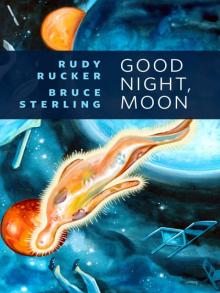 Good Night, Moon
Good Night, Moon Transreal Trilogy: Secret of Life, White Light, Saucer Wisdom
Transreal Trilogy: Secret of Life, White Light, Saucer Wisdom Complete Stories
Complete Stories The Sex Sphere
The Sex Sphere Surfing the Gnarl
Surfing the Gnarl Software
Software Mathematicians in Love
Mathematicians in Love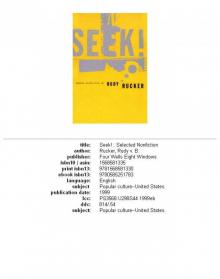 Seek!: Selected Nonfiction
Seek!: Selected Nonfiction The Secret of Life
The Secret of Life The Hacker and the Ants
The Hacker and the Ants Postsingular
Postsingular Spaceland
Spaceland Transreal Cyberpunk
Transreal Cyberpunk Sex Sphere
Sex Sphere Spacetime Donuts
Spacetime Donuts Freeware
Freeware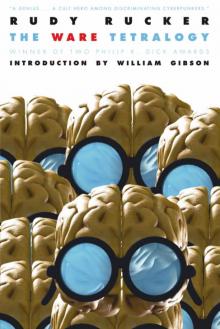 The Ware Tetralogy
The Ware Tetralogy Frek and the Elixir
Frek and the Elixir Junk DNA
Junk DNA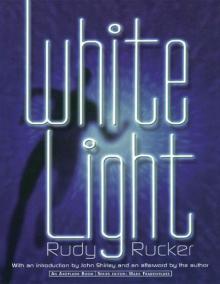 White Light (Axoplasm Books)
White Light (Axoplasm Books) Nested Scrolls
Nested Scrolls Inside Out
Inside Out Where the Lost Things Are
Where the Lost Things Are Mad Professor
Mad Professor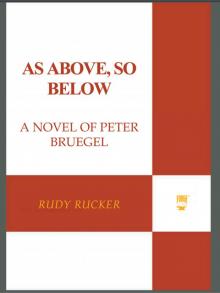 As Above, So Below
As Above, So Below Realware
Realware Jim and the Flims
Jim and the Flims Master of Space and Time
Master of Space and Time The Big Aha
The Big Aha Hylozoic
Hylozoic